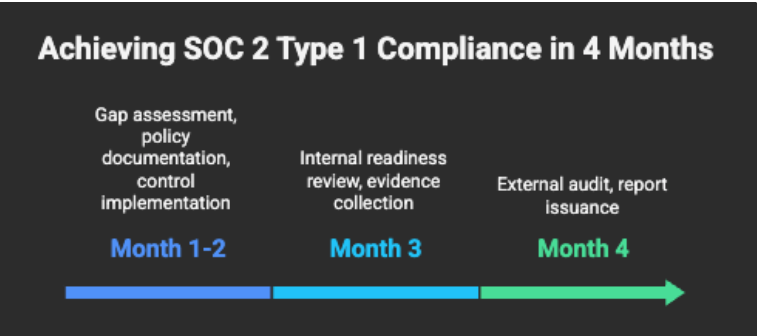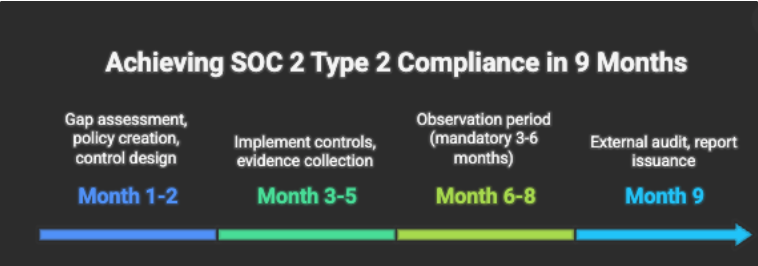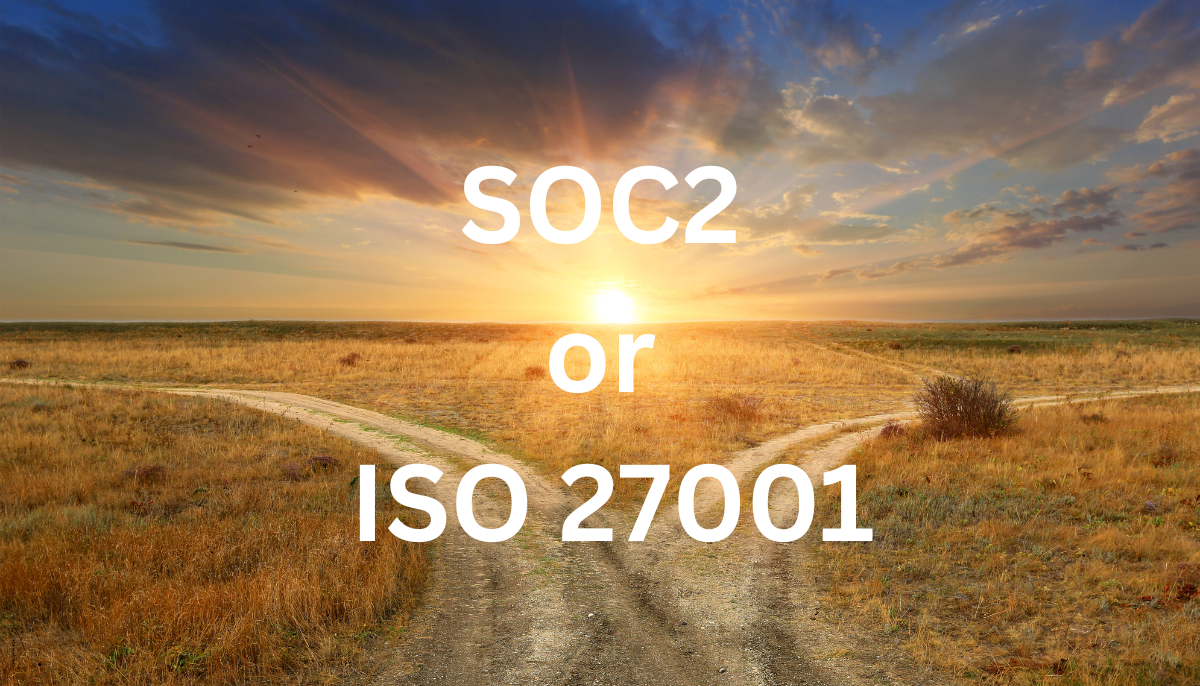Author: Marçal Santos, vCISO | +20 Years Cybersecurity Experience
Every founder asks me the same question: where should we invest first: SOC 2 or ISO 27001?
You’re not alone. The market is noisy. Tools promise push‑button compliance; auditors sell audits. What you need is a founder-friendly decision that unlocks deals fast without boxing you in.
I’ve helped dozens of B2B SaaS teams sequence this correctly. Here’s the 5-minute decision framework I use so you win revenue now and build toward both standards without rework.
Quick Answer: Is SOC 2 or ISO 27001 Better for Startups?
For US-focused B2B SaaS startups, SOC 2 is typically the better first choice because 87% of US enterprise buyers request it during procurement. It costs $15,000-$50,000 and takes 6-9 months for Type 2 compliance.
Choose ISO 27001 first if:
- 70%+ of your revenue comes from EU/UK/international customers
- Your prospects explicitly request ISO 27001 in RFPs
- You're in heavily regulated industries (finance, healthcare)
Bottom line: Choose based on where your customers are located and what they're asking for in security questionnaires.
Why This Choice Is Hard (And Where Smart Teams Slip)
Both sound similar. “Security certification, audit, trust, blah blah.” But SOC 2 and ISO 27001 are different instruments used by different buyers.
Sales pressure is real. A prospect dangles a big contract; you sprint into an audit… before you’re ready or before you’re sure it’s the right standard.
Tool ≠ outcome. Automation helps, but it won’t pick the right framework, write your SoA, or pass Stage 2 alone.
Your job: pick the standard that shortens your sales cycle and sets up a sane path to the other later.
Decision Framework: Which Certification Should You Pursue First?
Use this in order. If you answer “yes” to a line, pick that path.
1) Where are your current and next 12 months’ deals?
- Mostly US mid-market SaaS, IT buyers familiar with SOC 2? → SOC 2 first
- EU/UK-heavy or selling into global enterprises/government frameworks? → ISO 27001 first
2) What do your largest target customers explicitly require in contracts/security questionnaires?
- “SOC 2 Type II report” → SOC 2 first
- “ISO 27001 certification from an accredited body” → ISO 27001 first
3) How fast do you need a badge to unstick deals?
- Under 90 days, need something credible for NDAs/pilots → SOC 2 Type I now, Type II next
- You have a 3–6 month runway, enterprise pilots depend on a formal certificate → ISO 27001
4) How global is your go-to-market in 2025?
- US-only or US-first → SOC 2
- Multiregional now or soon (EU, APAC, public sector) → ISO 27001
5) Internal maturity and appetite:
- You want a lighter attestation focused on controls in practice → SOC 2
- You want an ISMS (risk-led management system) you can scale across business units → ISO 27001

🎯 Still unsure? Book a free consultation and we'll analyze your specific situation.
SOC 2 vs ISO 27001: Quick Comparison Table
| Factor | SOC 2 | ISO 27001 |
|---|---|---|
| Type | Attestation Report | Certification |
| Best For | US B2B SaaS startups | Global/EU enterprise customers |
| Cost (First Year) | $15,000 - $50,000 | $20,000 - $75,000 |
| Timeline |
3-5 months (Type 1) 6-9 months (Type 2) |
6-9 months |
| Geographic Focus | North America | International (preferred in EU/UK/APAC) |
| Scope | Service provider controls (5 Trust Service Criteria) | Entire organization ISMS (93controls) |
| Flexibility | Flexible - choose applicable controls | Prescriptive - must address all relevant controls |
| Maintenance | Annual audit required | Surveillance audits (Year 2 & 3), Recertification (Year 4) |
| Annual Maintenance Cost | $8,000 - $30,000 | $8,000 - $15,000 |
💡 Quick takeaway: If your customers are in the US, start with SOC 2. If international or EU-focused, start with ISO 27001.
Path A: SOC 2 First (Revenue-First for US SaaS)
What matters to sales:
- A clean SOC 2 Type I gets you through early security reviews.
- A Type II (6–12 months coverage) closes bigger, risk-averse buyers.
Indicative costs (2025 typical ranges):
- Tooling/automation: $7k–$20k/year depending on size and integrations.
- Pen test (app + infra): $5k–$20k.
- Audit (Type I): $5k–$10k; (Type II): $8k–$20k based on scope/period.
- vCISO/readiness help: $8k–$20k depending on lift.
💡Pro tip:
- If a whale is asking for SOC 2, negotiate the timeline for completion and make it a contractual commitment.
Path B: ISO 27001 First (Global, Enterprise, or EU/UK)
What matters to sales:
- An accredited ISO 27001 certificate unblocks global procurement and partner marketplaces.
Indicative costs:
- Tooling/automation: $7k–$20k/year .
- Pen test: $5k–$20k.
- Internal Audit: $2k–$7k.
- Certification body: $15k–$50k over 3 years (depends on headcount/scope), front-loaded at Stage 2.
- vCISO/implementation: $8k–$20k depending on maturity.
💡Pro tip:
Schedule and execute formal Management Review Meetings at least annually (ideally quarterly). The agenda must explicitly cover all required inputs: Internal Audit Results, Non-conformities, Risk Status, Control Performance, and Continual Improvement Opportunities. Document the decisions made and actions assigned to prove the leadership is actively governing the ISMS.
SOC 2 vs ISO 27001: Timeline Comparison
SOC 2 Type 1 Timeline: 3-4 Months
- Month 1-2: Gap assessment, policy documentation, control implementation
- Month 3: Internal readiness review, evidence collection
- Month 4: External audit, report issuance

SOC 2 Type 2 Timeline: 6-9 Months
- Month 1-2: Gap assessment, policy creation, control design
- Month 3-5: Implement controls, evidence collection
- Month 6-8: Observation period (mandatory 3-6 months)
- Month 9: External audit, report issuance

ISO 27001 Timeline: 6-9 Months
- Month 1-2: Gap analysis, ISMS design, risk assessment
- Month 3-5: Control implementation, documentation, internal audit
- Month 6-8: Stage 1 audit (documentation review)
- Month 9: Stage 2 audit (on-site assessment), certification

SOC 2 vs ISO 27001: Mistakes I See (And How to Avoid Them)
1) Buying the audit before you’re ready
- Symptom: Auditor calendar booked, your controls aren’t live, and you’re backfilling evidence.
- Fix: Do a readiness check first. Close the top 10 gaps. Book the audit for when you can pass the first time.
2) Scoping everything into your ISMS/system
- Symptom: Your entire corporate IT, every microservice, and three legacy tools are “in scope.”
- Fix: Scope to what processes customer data and what materially impacts it. Keep nice-to-have systems out.
3) Copy-paste policies you don’t live by
- Symptom: Beautiful policy PDF; no one follows it. Auditors find the drift instantly.
- Fix: Write policies that match reality. Improve reality, then update policy. Not the other way around.
4) Treating SOC 2 Type II as a finish line
- Symptom: Evidence fire drill every 11 months; nothing operational in between.
- Fix: Build an evidence calendar and automate the feed. Treat compliance as part of engineering hygiene.
5) Ignoring the risk assessment
- Symptom: Generic risks (“malware!”) unconnected to your architecture.
- Fix: Tie risks to your stack: multitenancy boundaries, LLM feature threats, third-party auth, data residency. Choose controls that address those risks.
SOC 2 vs ISO 27001:Frequent Asked Questions
How much does SOC 2 cost vs ISO 27001?
SOC 2 Type 2: $15,000-$50,000
ISO 27001: $20,000-$75,000
Costs vary based on company size, system complexity, current security maturity, and the scope of the certification.
Which is faster: SOC 2 or ISO 27001?
SOC 2 Type 1 takes 3-4 months. SOC 2 Type 2 takes 6-9 months due to the mandatory 3-6 month observation period.
ISO 27001 initial certification takes 4-8 months. The actual speed depends on your starting point; well-prepared startups can achieve either in 4-6 months.
Do I need SOC 2 if I have ISO 27001?
For most B2B SaaS buyers, having either SOC 2 or ISO 27001 is sufficient. However, for government contracts or sales into highly regulated industries, ISO 27001 is often a firm requirement.
Is SOC 2 recognized internationally?
SOC 2 is recognized globally but is most prevalent in North America. Customers in Europe, the UK, and APAC often prefer ISO 27001 because it's an international standard (ISO/IEC), is more familiar in their markets, and aligns with regulations like GDPR.
Can ISO 27001 replace SOC 2?
Not always. While ISO 27001 is more comprehensive, SOC 2 is specifically designed for service providers and includes Trust Services Criteria that US customers expect. If your customer contract explicitly requires SOC 2, ISO 27001 will not be an acceptable substitute.
What's the difference between SOC 2 Type 1 and Type 2?
A Type 1 report assesses the design of your security controls at a single point in time (taking 3-4 months to achieve). A Type 2 report assesses the operating effectiveness of your controls over a period of time, typically requiring a 3-6 month observation period. Most customers require a Type 2 report.
How long does SOC 2 last?
SOC 2 reports are considered valid for 12 months from the audit date. You must complete annual audits to maintain compliance, with re-audits typically costing between $8K-$30K annually.
How long does ISO 27001 certification last?
ISO 27001 certification is valid for 3 years but requires annual surveillance audits in Year 2 and Year 3 to maintain it. A full recertification audit is required in Year 4. Annual maintenance costs typically range from $8K-$30K.
What industries require SOC 2?
SOC 2 is most common for B2B SaaS platforms, cloud service providers, data centers, financial services technology, HR and payroll platforms, and healthcare IT systems.
Does ISO 27001 help with GDPR compliance?
Yes, partially. ISO 27001's framework aligns with many GDPR requirements for data protection and security. However, it does not cover all aspects of GDPR, so you will still need specific GDPR processes like privacy impact assessments and procedures for handling data subject rights.
Can a small startup get SOC 2?
Yes. Even pre-revenue startups with as few as 2-5 employees can achieve SOC 2. The key requirements are having defined security policies, implementing necessary controls (like access management and encryption), and being able to demonstrate that those controls have been operating for 3-6 months for a Type 2 report.
What happens if you fail a SOC 2 audit?
Technically, you don't 'fail' a SOC 2 audit, as it's an attestation, not a pass/fail exam. Instead, an auditor can issue a qualified opinion (some controls don't meet criteria), an adverse opinion (significant issues), or a disclaimer (unable to audit). Most companies will address the findings and get re-audited rather than accept a negative opinion.
Which is harder: SOC 2 or ISO 27001?
ISO 27001 is generally considered more prescriptive, requiring a formal Information Security Management System (ISMS), a comprehensive risk assessment, and adherence to over 93 controls from Annex A. SOC 2 is more flexible, as you select controls based on the relevant Trust Services Criteria. However, the mandatory observation period for SOC 2 Type 2 can make its timeline longer.
Do VCs care about SOC 2 or ISO 27001?
Yes, increasingly. For Series A and later funding rounds, VCs often see SOC 2 or ISO 27001 certification as proof of security maturity, a way to reduce customer acquisition friction, and a sign of lower liability risk. It's becoming a standard due diligence item, especially for B2B SaaS companies.
Can you do SOC 2 without a compliance platform?
Yes, but it's much harder and requires 200-400+ hours of manual, spreadsheet-based evidence collection. This manual process has a high risk of errors and makes auditing difficult. Compliance platforms (like Vanta, Drata, Secureframe) automate 60-80% of this work and typically provide a strong return on investment.
What's the ROI of SOC 2 vs ISO 27001 for startups?
The return on investment is typically measured by a 20-40% increase in enterprise deal closure rates, a 2-4 week reduction in sales cycle length, and access to enterprise customers who require compliance. It also significantly reduces the time spent on security questionnaires. The payback period can be as short as 3-6 months if compliance was blocking major deals.
Strategic Takeaway: This Is a Go-To-Market Decision
Selecting SOC 2 or ISO 27001 isn’t a theology debate—it’s a revenue strategy.
If your pipeline is mostly US mid-market and prospects say “send your SOC 2,” do SOC 2 Type I in 90–120 days, then Type II. Keep an eye on ISO mapping as you build.
If you’re selling to EU/UK or global enterprises, or marketplaces/partners require a certificate, do ISO 27001 first with a tight scope. It ages well and travels globally.
Ready to accelerate your ISO27001 or SOC2 compliance journey without the usual headaches and budget overruns?
At SecureLeap, we've revolutionized the compliance process by bundling everything you need into one seamless experience:
✅ Platform Licenses: Direct access to Vanta, Drata, or Secureframe at competitive rates
✅ Expert vCISO Guidance: 20+ years of hands-on compliance experience
✅ Audit Services: Vetted auditor network with proven track records
✅ Ongoing Support: Continuous monitoring and maintenance to ensure sustained compliance
Why choose SecureLeap over managing multiple vendors?
• Single Point of Contact: No more juggling between platform support, consultants, and auditors
• Transparent Pricing: Fixed-fee packages with no surprise costs or scope creep
• Ongoing Partnership: We're with you for renewals, expansions, and additional certifications
Don't let compliance slow down your enterprise sales momentum. Get a personalized compliance roadmap and pricing in just 30 minutes.
Book Your Strategic Compliance Consultation →
Or
Contact us using this form.

